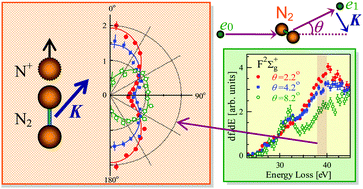Stereodynamics of electron-induced dissociative ionization of N2 studied by (e, e+ion) spectroscopy
Abstract
We report an (e, e+ion) spectroscopy study on electron-induced dissociative ionization of N2. Vector correlation between the scattered electron and N+ ion has been measured for inner-valence ionization of N2 at an incident electron energy of 1.4 keV and scattering angles of 2.2°, 4.2°, and 8.2°. By analyzing the experimental data, partial ion yield spectra have been obtained for transitions to the C 2Σ+u, F 2Σ+g, and 2σ−1g ion states, showing that the individual transitions depend on the momentum transferred to the target, K, in different ways. The molecular-orientation dependence of the ionization cross section has subsequently been examined for the F 2Σ+g ionization. To account for the angular anisotropy of the scattering cross section, a compact analytical form has been developed. It is elucidated that for small K the F 2Σ+g ionization preferentially takes place when the molecule has its axis aligned parallel to the momentum transfer vector due to σu shape resonance, while the angular distribution drastically changes with K, indicating strong influences of non-dipole interaction on the ionization dynamics. It has been shown that the present method provides a powerful means to explore K-dependent stereodynamics in electron-induced dissociative ionization of molecules.



 Please wait while we load your content...
Please wait while we load your content...